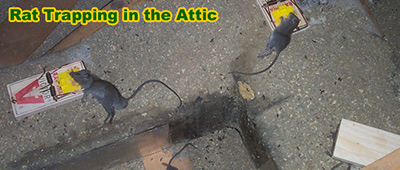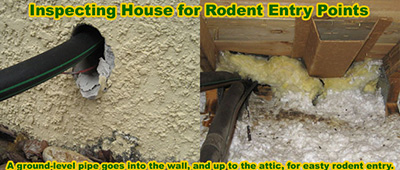I am, quite possibly, the world's best dead rat removal person. Yes yes, you can stop applauding now, thank you, thank you, sit down, you're too kind.
Several times a month, I am called out to a home, or office, commercial building, etc. because the occupants smell a horrible odor. They call me of course, because they suspect a dead animal body. Sometimes
I remove dead opossums, raccoons, squirrels, but most of the time, I remove dead rats. Rats live in buildings in high numbers, and they don't usually live a long life span. But more often than that, rats
are victims of poisoning, and when rats eat rodent poison set inside a building, guess where they usually die? Inside that building.
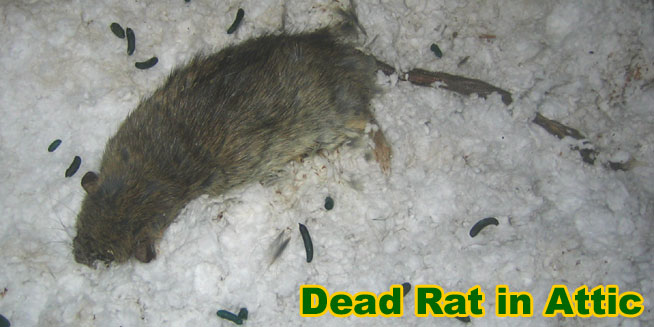
Look at the above photograph. It's a dead rat in the attic, a few days old (note some of the fur starting to fall off). You'll see that the rat droppings (poop) around the body is actually blue-green. This is from the blue-green dye in the poison. The poison takes 24-36 hours to kill the rat, so it goes through the system first, and they poop is the same color as the poison. Proof positive that it died due to the poison, yes, and proof positive that it died near where it ate the poison (no, they don't go outside to die, that's a ridiculous myth - why would they do that?)
How to get rid of dead rat odor - well, you find and remove the carcass, that's 99% of it right there. Then you spray the area down with a special cleaner, and open the windows and air out the place.
WHAT'S THE SECRET TO FINDING THE DEAD RODENT?
The secret is right below your nose. I mean, right in your nose. The secret is your nose. You sniff around, like a dog, basically, until you find it. This can be hard
for many people, because the whole building stinks. Sure, the smell might be worse in one area of the house, or even one room in particular, but where is that dead rat?
Aha, this is where my expertise comes in. I can tell, at first whiff, the species of dead animal, and I can tell, after some sniffing, if it's in the ceiling, wall, duct, etc.
It's just a matter of experience, knowledge of rat behavior, knowledge of architecture, and knowledge of "scent behavior", or air flow. I can just plain pin it down. I move
back and forth, sniff sniff, up and down, sniff sniff. When you get closer to the source, closer to that rotting gold mine, the smell not only gets stronger, but it changes.
Like a fine scotch, there are subtle hints of nutmeg, sherry, oak, maggot, etc. Once I hit ground zero, I bag the prize.
HOW TO FIND A DEAD RAT IN THE ATTIC
If your nose brings you to the attic, it can be tricky, because air flow in an attic is so good. Attics are well-ventilated, and that can be a problem. The smell is actually worse
inside the house, even though the dead rat is in the attic. And it can also be tricky, because very often the little bastard has died in a burrow underneath the insulation. Pay
attention to where the odor was worst in the house, and go to that area. Then, it's the good old sniff routine.
HOW TO FIND A DEAD RAT IN THE WALL
If your nose brings you to the bottom of the wall - yes, dead rats tend to be at the bottom, not levitating in the middle of the wall - unless there's a cross stud - then you're going
to have to cut a hole in the wall to access the rat. Sometimes, such as in the photo on the right below, you can access a dead rat down a wall from up in the attic, but building
architecture rarely allows this. Most of the time I'm breaking out he trusty drywall saw and cutting a hole. I remove the rat, spray the area down, and fix the hole.

HOW TO FIND A DEAD RAT IN THE CEILING
If the rat is in a ceiling area but there's no attic to crawl into, it's the same basic deal. Pinpoint the area down to within an inch. To do this, you get on a stepladder and you
stick your nose right against the ceiling until you hit the unmistakable stench of the final resting place. Then cut a hole with the drywall saw, remove the rotten bugger, spray with
the cleaner, and seal up the hole with brackets or a drywall patch.
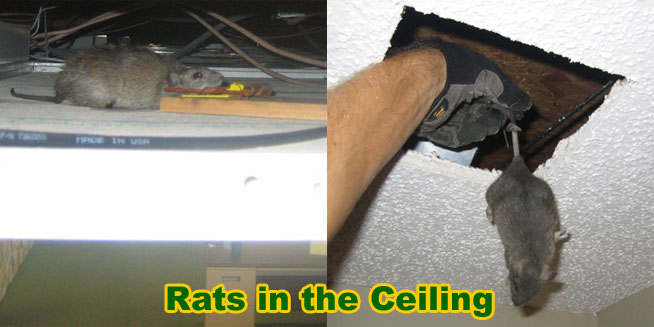
HOW DO YOU GET RID OF DEAD RAT SMELL
You get rid of dead rodent smell by removing the body, of course. You should also scoop up the maggots, so that the house doesn't get a fly hatch in 21 days. Then a number of cleaning
disinfectants will work, but I really like a product called Bac-Azap, which breaks down organic matter, such as rotting rat juices. Mmmm!!! After the animal is out, the smell will
quickly go away, but you can expedite the process by opening some windows and airing the place out.
THE SAME APPLIES TO MOUSE REMOVAL
Although I wrote this site with rats in mind, such as the Roof Rat and
Norway Rat, the same principles apply to other rodents, such as the
house mouse. Mice behave very similarly to rats, they're just smaller.
So it's often harder to find a dead mouse carcass, because the smell is much weaker than
a rat. I say that, and it still absolutely smells putrid. Dead mice stink just the
same as rats, and they die in the same sorts of areas, so the same techniques apply.
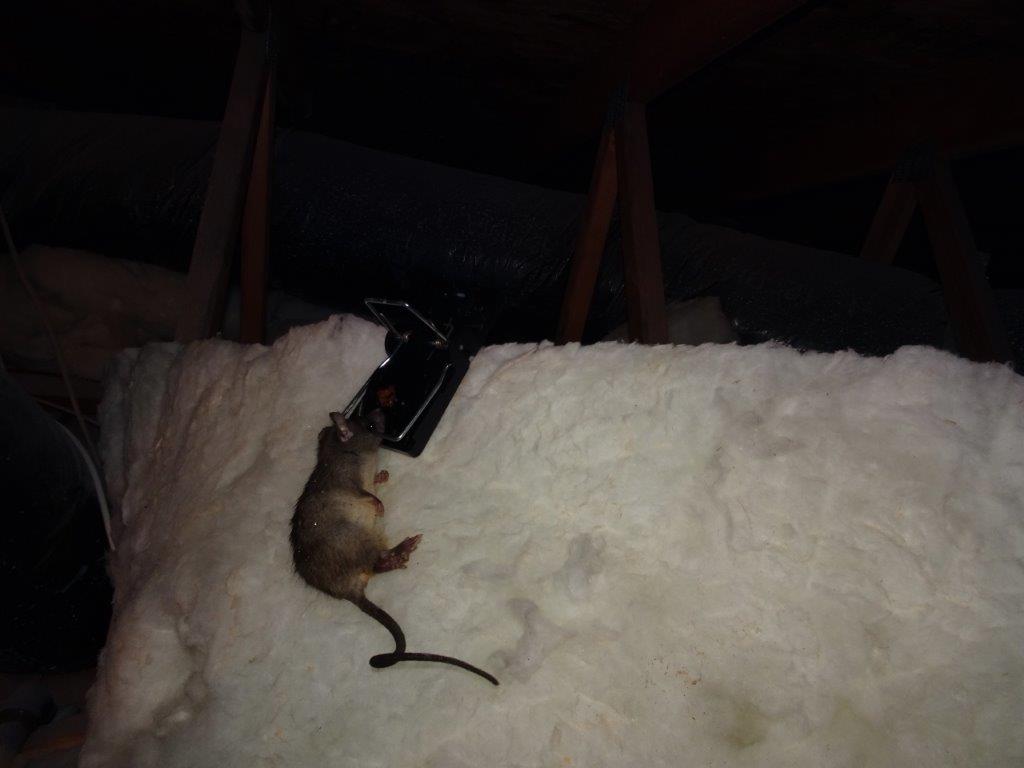
Will I have dead rats in my house if I use poison?
There really isn't any good that can come from using rat poison. We don't use it in our rat removal methods, and we wouldn't recommend it to those of you who are trying to rid your property of rodents, rats, mice, and other wild animals included. There are so many disadvantages to using poison and other chemicals, also including ammonia, and even mothballs to some extent. There are also a lot of "advantages" too, or so people think. The only problem with this is that many of the "advantages" that you hear about are entirely fluff. They're myths. They're also untrue.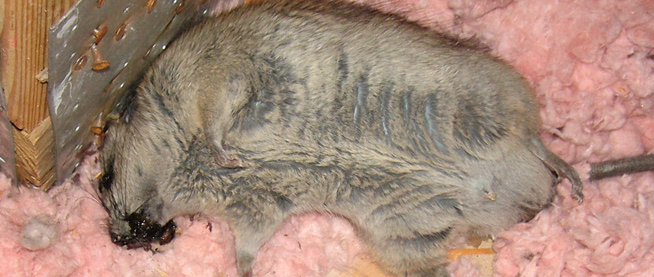
"Rat and mouse poison is both cheap and cost effective."
That's one statement I have personally read on the internet in the defence of rat, mouse and other rodent poison. Just to clear things up a little for you, using rat poison is not cheap or cost effective in the slightest. The destruction caused to your house by these rodents will not be cheap to repair, and when you consider that rat poison rarely works quite as effectively as you'd first hope, those rats are left to leave their trail of destruction. It often takes many weeks for rats to die after ingesting poison, and they can damage more stuff and make more babies during that time.
Also, just one more thing to bear in mind, rats will often find a warm and cosy spot in your home somewhere to die, and that body will be left to decompose and, in time, cause a really foul smell. You may need to remove actual sections of walls to find and remove the body, and therefore the smell.
That doesn't sound cheap or cost effective to me. Does it sound cheap and cost effective to you?
"Rat and mouse poison works quickly."
Once again, this is, in fact, a total myth. Rat and mouse poison doesn't work quickly at all. It can actually take many weeks for the rat to die. The way that this poison works is by stopping the clotting action of the blood. It causes internal bleeding, and this isn't something that causes death overnight. It is likely to take at least a week for the poison to start having effect, and in some cases it can even take much longer than that.
Rat and mouse poison doesn't work quickly, and because of this, you can't consider it to be a humane way of dealing with your rat problem. Quite the opposite, in fact.
"It works on several rats at once."
Okay, occasionally this might very well be the case, but now that we've told you what we've just told you, can't you understand why this would be a BAD thing? All of the destruction, the dead bodies, the decomposing and the smell ... Imagine that was many rats and mice, and not just one. Is that really something you want to actively encourage in your home?
No, we didn't think so.
The only really effective way to remove rats from your home is to hire a professional who DOESN'T use poison. Give us a call if you want to find out how you can also rat-proof your home yourself - we give out bundles of FREE and great advice!
Does poison cause thirst and death in rats?
What things have you heard about rat poison over the years? I bet you have heard the very common myth that rat poison makes rats thirsty, go outside in a bid to find water, and then die. Have you heard that? Well, we're not really sure who made that particular myth up, but it is just that - a myth.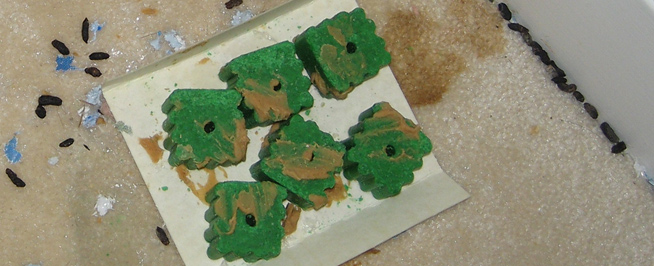
Poison is not a good approach when you have a rat problem. In fact, it's one of the worst methods you could choose. We would highly recommend using lethal snap traps if you want to cull these critters. In fact, snap traps are the best and most effective way to deal with these rodents. For more information, give us a call today. We can even give helpful advice over the phone.
Go back to the Rats in the Attic home page.
The smell is so pungent and strong; it makes it difficult to eat a meal in your kitchen or sit in your living room and watch television. You may wonder at one point if you are being poisoned by the smell of the dead rat in your home. You now have the job of trying to find and remove the dead rat from your house.
Rats can carry several diseases with them wherever they go and if they are living in your home, there is a good chance that you can catch one of these diseases. These diseases can cause yourself and your family to become ill so the sooner you can get rid of the dead rat, the safer it will be for you and your family.
Choices in Getting Rid of Rats
There are several choices to consider when you want to remove rats from your home. The most common choices include:
- Standard traps
- Live traps
- Poison
The most common way to get rid of rats is to poison them. When you poison them, you don’t have to worry about releasing them from the trap nor do you have to carry them in the live trap to a safe place away from your home to relocate them.
If you choose to feed the rat poison, you will want to find the rat once it died otherwise you will smell it. Here is a simple procedure that you can use to locate the dead rat.
Step 1: The rat will most likely still be close to where you put the poison. Check around the area thoroughly.
Step 2: Rats are going to be as close to the food as they can get. Your best option to locate the rat will be in the kitchen or pantry. First, inspect the kitchen for droppings that the rat may have left when he was scavenging around. Then you will want to also check the pantry where your food is stored. They can climb so be sure to check the shelves and inspect each individual bag or box for signs that a rat has been chewing. You can’t miss the big teeth marks that have pierced the box or bag at some point.
Step 3: The smell of a dead rat will linger in your home soon after death occurs. Start at one point on the wall in the living room and start smelling. Inhale long deep breaths as well as short shallow ones as you get closer to the smell. When the smell is not as strong, you are moving away from where the rat has died. Go toward the smell until you locate the strongest area you smell it in. That is where you can begin your quest to find it.
Step 4: If the rat died in the attic or air duct, you can find the rat best if you are elevated during the search. This requires that you get a ladder and move closer to the ceiling.
Step 5: Once you have located the dead rat, you will want to cut enough of the ceiling or the wall to remove the dead carcass. Once you cut the small hole, shine a light into the hole so you can locate the dead body. Once you find it, use a pair of rubber gloves to remove the rat carefully. Then dispose of the body.


